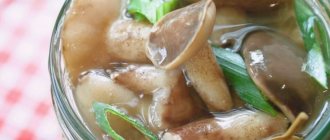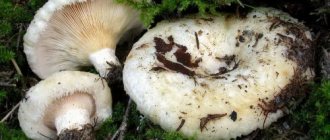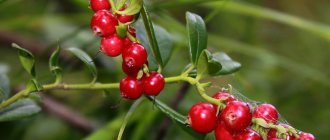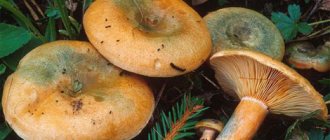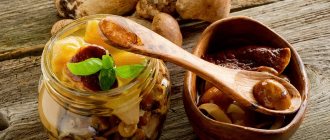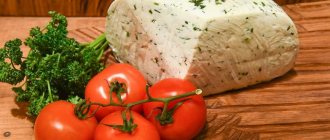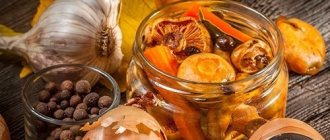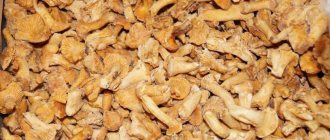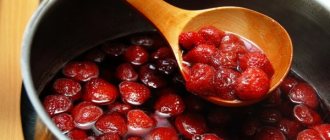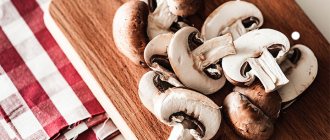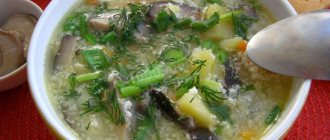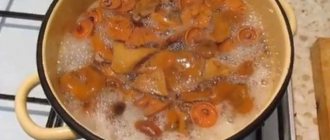All lovers of “silent hunting” are well aware of mushrooms with a characteristic orange-red color - these are saffron milk caps. Their beneficial properties have been known for a long time. Tasty and nutritious, they are considered the basis of many dishes, but the most popular recipe has become a recipe for cold salted saffron milk caps. There are quite a few variations of this kind of pickling, but any dish made from mushrooms retains their beneficial properties, and spices and herbs add pungency and piquancy.
You should find out how to properly salt saffron milk caps in a cold way, based on what recipes you can prepare the most delicious snacks. Knowing all the intricacies of salting will help you prepare preparations that can be classified as real Russian delicacies.
Preparing saffron milk caps for cold pickling
Before cold-salting saffron milk caps, they must be carefully prepared. Immediately after collection, they are sorted, damaged and wormy ones are removed, and sorted.
Important! For pickling, it is worth choosing fruit bodies of the same size so that they are evenly salted and have the same consistency.
Cleaning should be done as soon as possible so that the mushrooms do not deteriorate and become unusable. It makes sense to start it in the forest, removing dirt, cutting out defective areas and the rough part of the leg.
If you decide to salt saffron milk mushrooms using a cold method, then they need special processing:
- Clear of leaves and dirt.
- Rinse thoroughly using a sponge and toothbrush.
- Drain the dirty water and rinse again in clean water.
- Pour cold water into a glass container, add a few tablespoons of salt and place the washed mushrooms in it.
- Leave them in this solution for several hours.
- Drain the water.
- Rinse under running water.
- Wait until the excess liquid drains.
Hot preparation method - marinating
Many housewives prefer heat treatment of any forest products, and only after that they begin to prepare dishes for their intended purpose. The advantages of this method are obvious: the bitterness goes away from the mushrooms, and all kinds of microorganisms that have gotten into the pulp die. In addition, it becomes possible to add fruiting bodies to sauces, salads or baked goods, and not just eat them as an independent dish or snack.
So, in order to prepare pickled saffron milk caps, you will need:
- 1 kilogram of fresh forest products.
- 200 ml water.
- 1 teaspoon salt.
- 120 ml table vinegar (6%).
- 5 black peppercorns.
Prepared (cleaned of dirt, washed) saffron milk caps are placed in a colander or on a special mesh, doused with boiling water, and then set aside to cool. In the meantime, a marinade is prepared from half a glass of water with pepper and salt.
The resulting seasoned mixture with mushrooms is placed on the stove and boiled for 25-30 minutes over low heat. After the specified time has passed, table vinegar is added to the container with the marinade, then the cooking process is extended for another 20 minutes. The final stage is distributing the treats into pre-sterilized jars and sealing them with lids.
It is important that the filling of the jars is maximum, that is, you need to pour the marinade right up to the lid. Failure to comply with this condition increases the likelihood that the rolled mushrooms will become moldy and become unsuitable for eating. It is also necessary to adhere to storage rules: saffron milk caps will retain their taste and quality for the winter if you place them in a refrigerator or dark basement with an air temperature not exceeding +18 degrees.
In what container to salt saffron milk caps cold?
To prepare salted saffron milk caps in a cold way, you need appropriate utensils. Wooden tubs, glass or enamel containers without scratches, damage or chips are suitable. This can be used in jars, bottles, pans or buckets with lids.
You can salt saffron milk caps coldly in a glass jar only after it has been thoroughly washed and sterilized. Enameled cookware must undergo a similar treatment.
A wooden tub or barrel has long been considered the best container for salted saffron milk caps. The preferred material for their manufacture is oak or cedar. Today you can find such a container, but before you start salting in it, you need to make preparations. This applies to both new and used tubs:
- New barrels are soaked in water for two weeks to remove tannins, which can cause the fruiting bodies and brine to darken.
- The container is washed thoroughly.
- Steam with boiling water and caustic soda solution (50 g per bucket of water).
- Fumigate the damp tub with sulfur to destroy harmful organisms.
Important! You cannot salt in galvanized, aluminum or plastic containers, since the manufacturing materials can, when oxidized, release harmful substances that lead to poisoning.
Experts do not recommend salting saffron milk caps using a cold method in clay pots, since under the influence of salt it becomes unsuitable. It is quite possible that there is lead in the glaze of such dishes, which gets into the brine and poisons it.
How to pickle saffron milk caps for the winter in a cold way
The advantages of cold salting technology are that the product undergoes minimal processing, and all the vitamin composition and benefits from it are preserved.
The process of cold pickling of camelina mushrooms is as follows:
- For cooked, sorted and soaked mushrooms, the stems are shortened at a distance of about 1 cm from the cap.
- Pour a layer of salt onto the bottom of the container.
- Place the saffron milk caps in layers (about 10 cm), caps down.
- Sprinkle them with spices - garlic, pepper, bay leaf.
- Dill, black currant leaves, horseradish, and cherries are placed on top.
- A wooden circle wrapped in gauze is placed on the leaves.
- They crush him under pressure.
Salt consumption is 40 - 60 g per kilogram of saffron milk caps. Mushrooms can be added to a large container as they are collected.
Important! Oppression should not dissolve in water. You should not use a brick or a metal object that can rust for this purpose.
The salted product is ready for consumption within a month.
Why did the brine turn black when pickling saffron milk caps and what to do if the surface turns black?
Many housewives are interested in why the brine turns black when pickling saffron milk caps. This doesn't happen often, and as a result, it can be very scary. Sometimes such an unpleasant feature can really become a cause for concern. But if there is no unpleasant odor or black mold in the brine, then nothing bad has happened. You can safely eat them after rinsing them in water. Otherwise, if black mold is visible on the darkened brine, then the mushrooms should be thrown away, sparing no time and effort.
So, why can the brine of salted saffron milk caps turn black? It should be noted that the brine of salted saffron milk caps should have a rich dark brown color, this indicates its quality. So, if the mushrooms were crushed during the picking process, were poorly processed, were stored incorrectly, and often came into contact with air, then this may also affect the color of the brine. The same can be said about when the brine of salted saffron milk caps turns black only on the surface.
What to do if the brine in the saffron milk caps has turned black, what recommendations exist for this? You need to remove the top layer of mushrooms and drain the liquid. Then rinse the saffron milk caps, sprinkle them again with salt and fill them with new brine. In addition, if you want to play it safe, then boil the saffron milk caps for 10 minutes and pickle them hot.
Recipes for cold salted saffron milk caps
With this method, salted saffron milk caps retain their color, taste, shape, and aroma. Experts offer recipes that do not involve the use of spices to get pure mushroom flavor.
The method is very suitable for small young fruiting bodies.
Important! Cold salting of saffron milk caps for the winter can be divided into two types - wet and dry. The difference between them lies in the differences in preparing mushrooms for pickling. The first involves washing them, the second - only dry cleaning.
There are a lot of recipes for preparing salted saffron milk caps in a cold way:
- without spices;
- express method;
- traditional or classic;
- with onion;
- with horseradish and garlic;
- with mustard.
If recipes and storage rules are strictly followed, salted saffron milk caps turn out tasty, aromatic, do not sour, and do not spoil.
Simple cold salting of saffron milk caps without spices
For those who love the aroma of the gifts of the forest without the taste of spices, a simple and popular recipe for cold pickling of saffron milk caps, which contains only two ingredients, is suitable:
- coarse salt – 300 g;
- saffron milk caps - 1 bucket.
To prepare you need:
- Clean and rinse the mushrooms.
- Separate the caps from the stems.
- Place in layers in an enamel bucket.
- Sprinkle layers of salt, getting onto each mushroom.
- Place a flat plate or wooden circle on top.
- Install the load.
- Cover the top of the bucket with gauze.
- Transfer the container to a cool place for two weeks.
- Place salted saffron milk caps tightly into glass jars.
- Keep refrigerated.
Recipe for quick cold preparation of salted saffron milk caps
Mushrooms collected at the end of the season are best suited for winter. If they are received in July, you can use a recipe for pickling saffron milk caps in a very quick and cold way:
- Mushrooms are cleaned and washed.
- Place them in a saucepan.
- Add spices and herbs that you like.
- Thickly salted.
- Stir the contents of the pan.
- Salt again on top.
- Cover with a plate on top.
- After 2 hours, wash the salted mushrooms in running water.
The appetizer can be eaten seasoned with butter and onions.
Very tasty cold pickling of saffron milk caps with garlic and herbs
Cold pickling of saffron milk caps at home will turn out spicy if you use the following ingredients:
- fresh saffron milk caps – 3 kg;
- garlic cloves – 9 pcs.;
- bay leaf – 24 pcs.;
- peppercorns – 25 pcs.;
- currant leaves – 15 pcs.;
- coarse salt – 150 g.
Small specimens contain the most nutrients and vitamins. These are the ones that should be salted:
- Prepare the mushrooms by peeling and rinsing in running water.
- Prepare a container.
- Line the bottom of the container with bay and currant leaves.
- Add peppercorns.
- Sprinkle a layer of salt.
- Place a row of saffron milk caps on it, placing the caps down.
- Salt and sprinkle with spices again.
- Fill the entire container with layers of fruiting bodies and spices.
- Cover the top layer with currant and bay leaves.
- To salt the mushrooms, place a circle of wood and a weight on it.
- Transfer the container to a dark, cool place for 15 - 20 days.
- Place the finished product in sterile jars and close with sterile lids.
Recipe for cold salted saffron milk caps for the winter with onions
Among the many options for preparing salted saffron milk caps, there is a recipe with onions. For it you will need:
- fresh saffron milk caps – 2 kg;
- onions – 0.3 kg;
- allspice (peas) – 10 pcs.;
- rock salt, coarse – 100 g.
Cooking method:
- Dry cleaning of the fruiting bodies is carried out using only a brush and a damp cloth.
- Chop the onion, cutting it into thin rings.
- Mushrooms are placed in containers with their caps up, sprinkled evenly with onions, pepper, and salt.
- Cover the top with a clean cloth.
- Place a wooden circle and a weight on it.
- After a month, the salted saffron milk caps are ready and can be eaten.
Spicy cold pickling of saffron milk caps for the winter
Those who love spicy dishes may like the spicy cold pickling of saffron milk caps in jars, tubs, buckets or other suitable containers.
The recipe includes the following ingredients:
- fresh saffron milk caps – 2 kg;
- bitter ground black pepper – 8 g;
- allspice – 7 pcs.;
- bay leaf – 6 pcs.;
- coarse salt – 90 g;
- black currant leaves – 40 g.
Preparation procedure:
- Clean mushrooms from debris.
- Lay them out in one layer on a sieve.
- Scald twice with boiling water.
- Sprinkle with ice water.
- Let it dry.
- Currant and bay leaves and pepper are placed at the bottom of the container.
- Mix ground pepper with salt.
- Place the saffron milk caps in layers and sprinkle with the salty mixture.
- Cover with a clean cloth.
- Place a circle and a weight on it.
- Salted saffron milk caps are ready in a month.
- Store the product at a temperature of 5 ⁰C.
If it is impossible to constantly maintain the temperature, you can increase the amount of salt used by a quarter, which will allow them to be preserved much longer at a higher temperature.
Spicy salted saffron milk caps in a tub turn out great. To do this, perform the following steps:
- Prepare a tub by placing juniper branches on the bottom.
- Pour boiling water over them and cover the container with a blanket.
- Throw hot stones into the tub to create steam and disinfect the container.
- Dry cleaning of saffron milk caps is carried out.
- Mushrooms are placed in a tub in layers, interspersed with horseradish leaves, dill, oak and cherry leaves, and garlic.
- Place a gauze bag with salt on top so that it spreads over the entire surface.
- A wooden circle and pressure are placed on the salt.
- When the load begins to descend, part of the released mushroom juice is scooped out.
The saffron milk caps are ready in two months. During this time, they not only become salted, but also slightly fermented, acquiring a unique rich taste.
What to do if saffron milk mushrooms turn black
Signs that it is necessary to take measures to save the workpiece:
- the appearance of foam on the surface means that the liquid has begun to ferment;
- the fruiting bodies of the upper layer turned black, the caps became slippery;
- mold has appeared;
- The brine gives off a sour or musty smell.
Camelinas are distinguished by a high level of protein in the fruiting body, so a spoiled product has the smell of decomposition and acid. Such workpieces are not recycled. In other cases:
- The mushrooms are taken out of the container.
- The top layer is discarded.
- The rest are washed in water with added salt.
- The old brine is poured out.
- Wash the container with baking soda.
- Treat with boiling water.
- The saffron milk caps are laid in layers.
- Sprinkle with salt.
- Boil water, cool and add to the container so that the workpiece is completely covered.
- They place the load.
- Place in a cool place.
You can package the product in sterilized glass jars using the same technology.
If there is no musty smell, and mold has appeared on the surface, the mushrooms are washed, boiled for 10 minutes to kill the spores and processed according to the method described above. If the product is stored in a small container, it can be used for frying or preparing first courses. The fruiting bodies are first washed in cold and then in hot water, left to soak for 1 hour and used.
How many days are saffron milk caps cold-salted?
There are several opinions regarding how long the salting process lasts. Some believe that a week is enough for cold salting, others - at least a month.
It all depends on when the product will be used for food. Within a couple of days after salting, you can start trying the delicacy. They lose their bitterness, but remain elastic and crispy. If you plan to eat the prepared delicacy soon, you need to use less salt; long-term storage requires more salt.
Terms and conditions of storage
Salted saffron milk caps can be preserved only if the temperature regime is observed. The room must be ventilated, the temperature in it must be maintained at a level not lower than 0 ⁰C, so that the products do not freeze and lose their quality. At temperatures above 5 ⁰C, cold-salted saffron milk caps may turn sour. It is necessary to ensure that the mushrooms are completely covered with brine. If there is a deficiency, it must be replenished with salted boiled water.
If mold appears on a weight, mug or gauze, they must be washed in hot salted water, and the walls of the container must be carefully wiped with a cloth.
Important! Shelf life depends on the amount of salt used for preparation.
With the express method, little salt is used, storage is carried out in the refrigerator, otherwise the product will quickly sour.
For long-term storage, it is considered optimal to use 40 g of salt per 1 kg of fruiting bodies.
